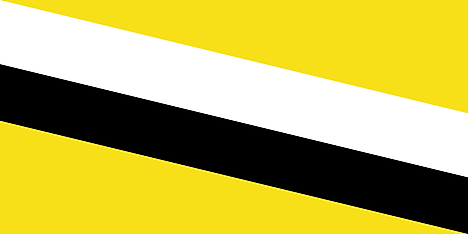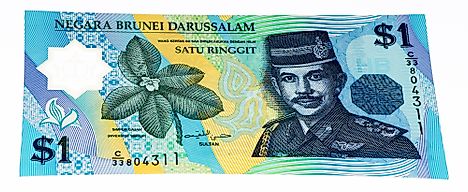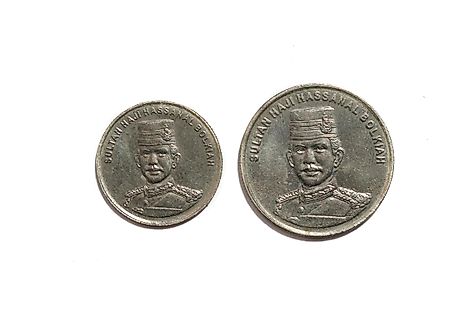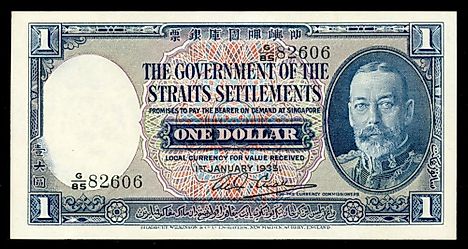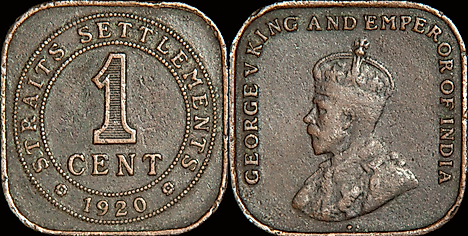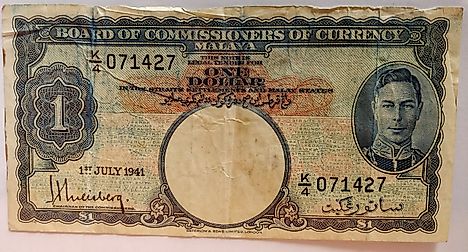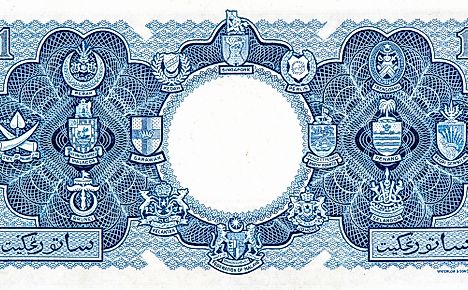Flags, Symbols & Currency of Brunei Darussalam
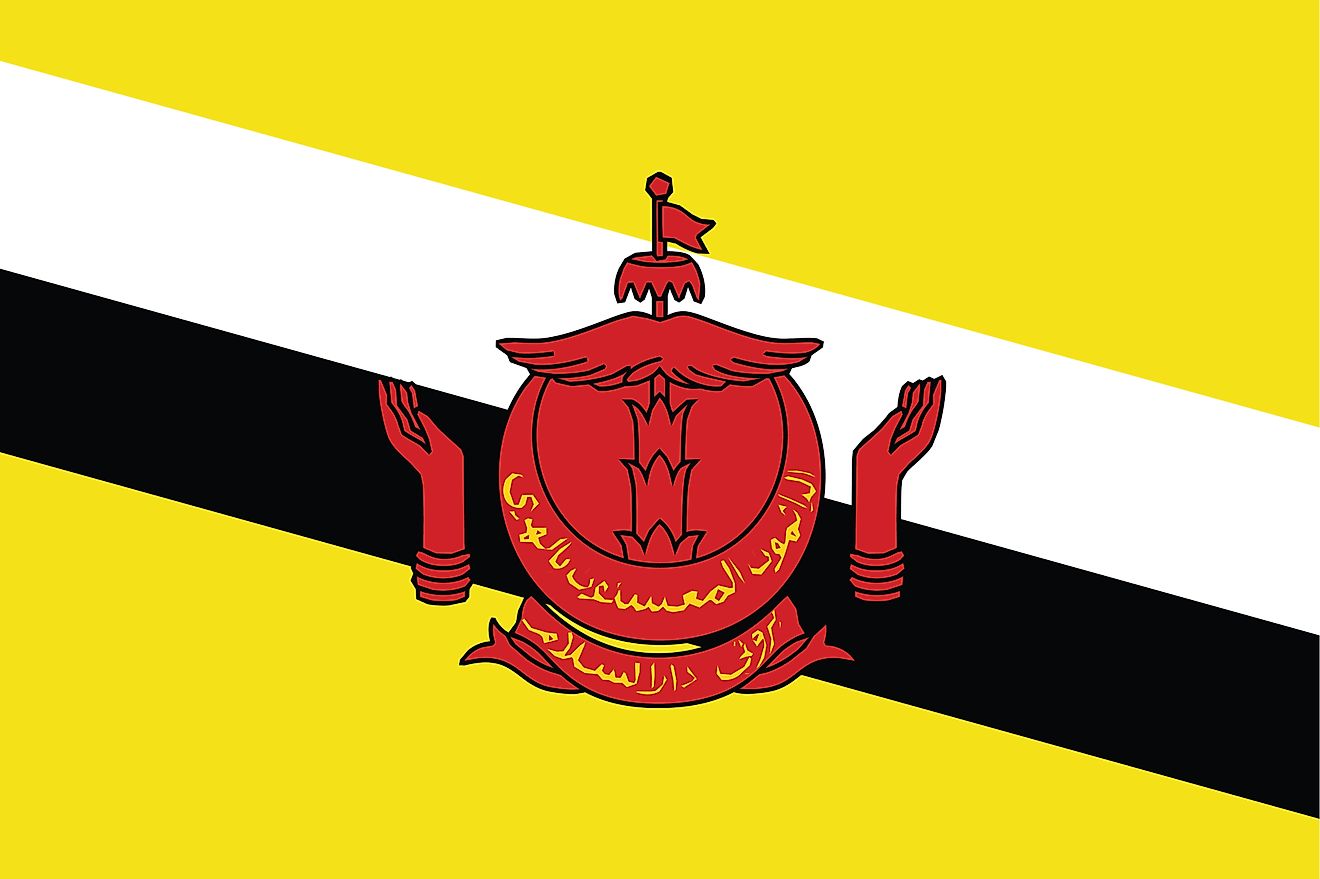
The Brunei flag was officially adopted on September 29, 1959, when the country was a British protectorate and was retained when the country gained independence on January 1, 1984, as Brunei Darussalam (“Brunei, the Abode of Peace”).
The National flag of Brunei Darussalam is rectangular shaped and has a yellow background with two diagonal bands of white (top, almost double width) and black starting from the upper hoist-side. The National Crest in red is superimposed at the center of the flag. Embodied in the crest in yellow Arabic script is the national motto that can be translated: “Always Render Service with God’s Guidance”. The color yellow is the color of royalty and symbolizes the Sultanate. The white and black bands denote the two chief ministers of Brunei, who advise the Sultan and serve as regents when he is unable to rule. The flag has a width: length proportion ratio of 1:2.
History of the flag of Brunei Darussalam
The predecessor to the modern flag of Brunei was adopted in 1906 when the country was a British protectorate. The new flag of Brunei featured the yellow background and a pair of stripes as the modern flag, but it did not include the nation’s crest. The national crest was added to the flag in 1959. The flag was retained as the national flag of Brunei Darussalam when the country gained independence on January 1, 1984.
Symbols of Brunei Darussalam
The National Coat of Arms of Brunei Darussalam
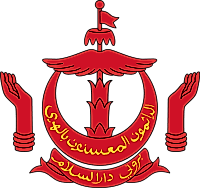
The national coat of arms of Brunei Darussalam, designed by the 3rd Sultan of Brunei – Sharif Ali was officially adopted in 1940. It includes five main components: a swallow-tailed flag, the royal parasol (ceremonial umbrella), the wings of four feathers, the two upraised hands, and the crescent moon. The swallowtail flag and the parasol represent the sultanate’s monarchy; the wings of four feathers symbolizing justice, tranquillity, prosperity, and peace. Below these, the crescent moon denotes Islam – Brunei’s state religion. On the sides, the two upraised hands signify the government's pledge to preserve and promote the welfare of the citizens and to protect the people. Brunei’s national motto: "Always render service with God's guidance" appears in yellow Arabic script on the crescent and on a ribbon (scroll) below the crescent, the country’s name: Brunei Darussalam (“Brunei, the Abode of Peace”) is inscribed in yellow Arabic script.
National Motto:
"Sentiasa membuat kebajikan dengan petunjuk Allah" ("Always render service with God's guidance")
National Anthem
- Anthem Title: "Allah Peliharakan Sultan" ("God Bless The Sultan")
- Music Composer: Haji Awang Besar bin Sagap
- Lyricist: Pengiran Haji Mohamed Yusuf bin Pengiran Abdul Rahim
- Date of Adoption: January 1, 1984
"Allah Peliharakan Sultan" ("God Bless The Sultan") is the national anthem of Brunei Darussalam. The music was composed by Haji Awang Besar bin Sagap in 1947 and was written by Pengiran Haji Mohamed Yusuf bin Pengiran Abdul Rahim. It was adopted as the national anthem of the British protectorate of Brunei in 1951. The song was officially adopted as the National Anthem of Brunei Darussalam upon its independence from UK on Januray 1, 1984.
Allah Peliharakan Sultan (Malay)
Ya Allah lanjutkanlah Usia
Kebawah Duli Yang Maha Mulia
Adil berdaulat menaungi nusa
Memimpin rakyat kekal bahagia
Hidup sentosa Negara dan Sultan
Ilahi selamatkan Brunei Darussalam
God Bless the Sultan
O Allah, we plead and cry to Thee,
Our Sultan and King, him a long life lease,
Help him rule thy lands, disposition wise,
Gates of glory and joy he shall boldly prise,
Peace be on our land, peace be on our Sultan,
God save Brunei, our beloved abode of peace.
The Currency of Brunei Darussalam is the Brunei dollar
The official currency of Brunei Darussalam is the Brunei dollar (B$, BND). It was first issued in 1967. The Monetary Authority of Brunei Darussalam is responsible for issuing the currency. The Bruneian dollar is divided into 100 subunits called cents. The Brunei dollar is interchangeable with the Singapore dollar and is sometimes used as a customary tender in Singapore. The Bruneian dollar is issued in both coins and banknotes.
Coins
Coins are available in denominations of 1, 5, 10, 20, and 50 cents.
Banknotes
Currency notes in Brunei are commonly issued in denominations of 1, 5, 10, 50, and 100 dollars, whereas 20, 25, 500, 1000, and 10,000-dollar notes are produced but much less common. Brunei also prints commemorative banknotes to mark the anniversary of various events.
Brunei has released banknotes in several series. The first series was issued in 1967 in denominations of 1, 5, 10, 50, and 100-dollar bills. The notes differed in color, with the notes coming in blue, green, red, brown, and purple colors. The second series of the Brunei dollar was released in 1972, and all notes had the portrait of Omar Ali Saifuddin III, who was the 28th paramount ruler and sultan of Brunei. In addition to the five denomination banknotes of the 1967 series, orange $500 and the brown $1000 notes were introduced and included the portrait of Hassanal Bolkiah, the 29th sultan of Brunei. A third series was released in 1989. The 10,000-dollar note was introduced in 2014, and with a value of $8000 US dollars, it is considered to be the most valuable banknote in the world. The fourth series was introduced between 1996 and 2000, and yet another series was released between 2004 and 2007, and later in 2011.
Historical currencies of Brunei Darussalam
The use of currency in Brunei is as old as the formal and informal trade networks on the island nation. In the barter trade, cowrie shells and bronze pots were used as currency. Tin coins were introduced around the 12th century. Chinese coins were the earliest to be used in the country, mainly due to close links between China and Brunei. The pitis was the first Brunei-made currency and was used from the 16th century until the 20th century when it was replaced by the Straits dollar. The Straits dollar was introduced in Brunei in 1906, and then later replaced in 1939 by the Malayan dollar. The Malayan dollar had an equal value to the Straits dollar and was used within the British colonies. In 1953, the British Borneo dollar was introduced but later replaced by the Brunei dollar in 1967.

